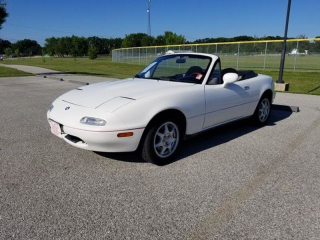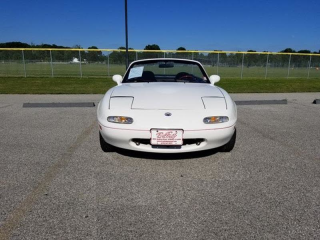The Good
The 1995 Miata boasts exceptional handling and a spirited 1.8L engine, offering an exhilarating drive that appeals to emotional buyers. Its renowned Mazda reliability and excellent fuel efficiency provide practical advantages. The timeless, simple design, comfortable cockpit for its class, and outstanding value retention make it a smart choice for those seeking an affordable, fun, and dependable sports car.
The Bad
Potential weaknesses for the 1995 Miata include rust, especially in rocker panels and rear quarter panels. Interior space is limited for taller drivers, and road noise can be significant with the soft top. The relatively small engine may feel underpowered for some, and the lack of advanced safety features is a consideration for modern drivers. Clutch slave/master cylinders are common failure points.
1995 Mazda MX-5 Miata: Quick Overview
- Engine Options:
- The 1995 Mazda MX-5 Miata came exclusively with a 1.8-liter DOHC (Double Overhead Camshaft) 16-valve inline-4 engine, introduced in 1994, replacing the earlier 1.6L unit. - Horsepower:
- This 1.8L engine produced 133 horsepower at 6,500 rpm and 114 lb-ft of torque at 5,000 rpm. - Fuel Economy (Estimated EPA):
- Manual Transmission: Approximately 22-23 mpg city / 28-29 mpg highway.
- Automatic Transmission (less common): Slightly lower, around 20-21 mpg city / 26-27 mpg highway. - 0-60 MPH Acceleration:
- With the 5-speed manual transmission, 0-60 mph times typically ranged from 8.0 to 8.5 seconds, which was respectable for its class at the time. - Towing Capacity:
- The Mazda MX-5 Miata was not designed for towing and therefore has no official towing capacity. Attempting to tow with this vehicle is not recommended and could damage the drivetrain. - Trim-Level Features (Common across NA models, specific for 1995):
- Base Model: Standard features included a manual soft top, power mirrors, power windows, an AM/FM stereo with cassette player, a tilt steering wheel, and 14-inch steel wheels with wheel covers. Air conditioning and power steering were often optional. - - "A" Package: Added popular comfort and convenience items such as power steering, alloy wheels (typically 14-inch), and cruise control.
- - "B" Package: Built upon the "A" package by including power windows, a leather-wrapped steering wheel, and a more robust stereo system with a CD player option.
- - "R" Package: This was the performance-oriented trim, primarily for enthusiasts. It omitted power steering and other luxuries to save weight. Key features included a sport suspension with Bilstein shocks, a Torsen limited-slip differential (LSD), front and rear spoilers, and 15-inch alloy wheels. It focused on pure driving dynamics.
- - M Edition: For 1995, the "M Edition" was a special edition offering unique paint (Merlot Mica), polished alloy wheels, tan leather interior, Nardi shift knob, and special badging, along with features from the "B" Package and often a limited-slip differential. These special editions typically included all available comfort options.
1995 Mazda MX-5 Miata Specifications
Vehicle Information
| Year | 1995 |
| Make | Mazda |
| Model | MX-5 Miata |
| Trim | - |
| Style | 4-Speed Automatic |
| Type | Convertible |
| Category | Sports Car |
Manufacturing Details
| Made In | Japan |
| Manufacturing City | HIROSHIMA |
Dimensions
| Doors | 2-Door |
| Curb Weight | 2424 pounds |
| Gross Vehicle Weight Rating | - |
| Overall Height | 48.20 inches |
| Overall Length | 155.40 inches |
| Overall Width | 66.00 inches |
| Wheelbase Length | 89.20 inches |
| Standard Seating | 2 |
Engine & Performance
| Engine | 1.8-L L-4 DOHC 16V |
| Engine Size | 1.8L |
| Engine Cylinders | 4 |
| Transmission | 4-Speed Automatic |
| Transmission Type | Automatic |
| Transmission Speeds | 4-Speed |
| Drivetrain | Rear-Wheel Drive |
Additional Features
| Anti-Brake System | 4-Wheel ABS |
| Steering Type | Rack & Pinion |
Pricing
| Manufacturer Suggested Retail Price (MSRP) | $23,530 |
| Invoice Price | - |
| Delivery Charges | - |
Vehicle History Report
Specifications
History
Events
History Check
Check
Check
Check
Check
Listings
Recalls
Check
Analysis
What Problems Does the 1995 Mazda MX-5 Miata Have?
Rust is a significant long-term reliability concern, especially in areas where salt is used on roads. Common rust spots include the rocker panels, rear quarter panels (around the wheel arches), and sometimes the chassis rails. Soft tops are prone to wear, tears, and leaks, particularly around the plastic rear window, necessitating replacement after years of exposure. The original plastic rear window can also become cloudy and brittle.
Cooling system components, like the radiator (which can become brittle plastic and crack), water pump, and thermostat, are known to fail over time due to age. Maintenance of the cooling system is crucial. The original stock coil packs can also degrade, causing misfires or rough idling.
Early NA Miatas (1990-1993) had an issue with failing power window motors, but by 1995, this was generally improved, though old motors can still slow down. Valve cover gaskets and oil pan gaskets are common leak points. Furthermore, suspension components like bushings and shocks will inevitably wear out, affecting handling. No major, widespread recalls specific to the 1995 model year regarding critical safety or powertrain issues are widely noted, beyond general automotive maintenance advisories and potential airbag recalls which affected many vehicles of that era and are typically addressed by now.
How long will the 1995 Mazda MX-5 Miata last?
Weaknesses over time, beyond typical wear and tear, include increased susceptibility to rust on the chassis and body panels in corrosive environments. Soft tops, cooling system plastics, and rubber components (like bushings and seals) will degrade and require replacement due to age and exposure. Electrical gremlins are rare but can occur in aging wiring. However, with accessible parts and a large enthusiast community, most issues are addressable, contributing to their longevity.
What Technology & Safety Features are Included?
Driver-assistance features were virtually non-existent by modern standards. There was no traction control, stability control, or anti-lock braking system (ABS) as standard, though ABS was an optional extra for the 1995 model year, offering a rudimentary form of braking assistance. Power steering was also an option, not standard, reflecting its back-to-basics ethos. Other conveniences like power windows and power mirrors were available as part of option packages.
Safety features were equally fundamental. Standard safety equipment included driver and passenger airbags, which were a significant inclusion for a small roadster of its era. Three-point seatbelts were also standard. Side-impact protection was limited by the car's small size and convertible nature. There were no advanced features such as blind-spot monitoring, lane-keeping assist, or adaptive cruise control.
Crash-test ratings for vehicles of this vintage are generally less comprehensive and harder to find than for modern cars. The NHTSA (National Highway Traffic Safety Administration) did not perform extensive crash tests on many vehicles in the mid-1990s as they do today, especially for niche sports cars like the Miata. Information regarding specific crash ratings for the 1995 Miata is scarce, but it's important to understand that its crash performance would not compare favorably to contemporary safety standards due to its size, construction, and lack of advanced protective features. It offers essential passive safety features for its time but lacks the robust protection of modern vehicles.
What Colors Options are Available?
1995 Mazda MX-5 Miata Prices and Market Value
Today, the used market prices vary significantly based on condition, mileage, and originality. Well-maintained examples can fetch anywhere from $8,000 to $15,000+, with rare or exceptionally preserved models (especially "R" or "M" Editions) commanding even higher prices. Average examples might be found between $4,000 and $7,000. Factors affecting resale value include the absence of rust, intact soft top, original paint, low mileage, comprehensive maintenance records, and desirable factory options like the limited-slip differential. Conversely, heavy modifications, neglected maintenance, or significant rust can severely depress its value. Its classic status and enthusiast following have led to strong appreciation in recent years.
1995 Mazda MX-5 Miata Cost of Ownership
Common repairs, like clutch cylinders or cooling system components, are also reasonably priced. Long-term ownership costs are low provided the car is free of significant rust or major deferred maintenance. While age means some components will inevitably wear out, the Miata's legendary reliability makes it a budget-friendly enthusiast car, far from costly to run.
1995 Mazda MX-5 Miata Fuel Efficiency
1995 Mazda MX-5 Miata Safety Rating
NHTSA
IIHS
1995 Mazda MX-5 Miata Warranty
Basic
Powertrain
Rust
1995 Mazda MX-5 Miata Insurance
reasonable repair costs.
How Does the 1995 Mazda MX-5 Miata Compare to Other Convertible?
Performance: The Miata's 133hp 1.8L engine is not a powerhouse, but its lightweight (around 2,200 lbs) and perfectly balanced chassis deliver unparalleled handling and driver engagement. The Toyota MR2 Turbo, with its mid-engine layout and up to 200+hp, offered significantly more straight-line speed and a more exotic feel, but could be more demanding to drive at the limit. The Honda CRX del Sol was FWD, offering less dynamic purity than the RWD Miata, and generally lower power. The BMW Z3 (introduced later) offered more power and luxury but at a much higher price point and greater weight.
Features: The Miata was purposefully spartan, with power windows, power steering, and ABS as options. Rivals like the MR2 offered similar levels of basic features, while the del Sol also focused on simplicity. The BMW Z3, however, provided a more premium interior, more advanced safety features (like standard ABS and traction control), and more comfort amenities.
Reliability: This is where the Miata truly excelled. Its Japanese engineering led to outstanding reliability, often surpassing rivals. The MR2 was also quite reliable but its mid-engine layout could make some maintenance tasks more challenging. The Honda del Sol was also a paragon of reliability. Older European alternatives like the Alfa Romeo Spider, while charming, couldn't match the Miata's bulletproof reputation for mechanical longevity and low maintenance.
Price: The Miata's biggest advantage was its affordability, both new and used. It offered roadster thrills at a fraction of the cost of European competitors. The MR2 was generally more expensive due to its more complex design and higher performance variants. The del Sol was competitive on price but aimed at a slightly different buyer with its FWD and removable Targa top.
Alternatives: For a similar pure, affordable roadster experience, a used Honda S2000 (though a generation newer and more expensive) offers higher performance and reliability. For those seeking more power and a different driving dynamic, a clean Toyota MR2 Turbo is an excellent but pricier alternative. If reliability and open-top fun on a budget are priorities, the Miata remains a top choice; finding a well-preserved NA Miata often outshines alternatives due to its robust aftermarket support and enduring appeal.
Final Verdict: Is the 1995 Mazda MX-5 Miata a Good Convertible?
It is absolutely worth buying, especially in the current used market where its value continues to appreciate. The NA Miata offers incredible smiles per dollar. Conditions for purchase should prioritize a rust-free chassis and body, a well-maintained engine, and a functional soft top. While any trim provides enjoyment, the "R" Package or "M" Edition models are highly desirable for collectors and those seeking specific performance or aesthetic features. Buying used is the only option, and focusing on condition rather than just mileage is paramount for these nearly 30-year-old vehicles. A pre-purchase inspection is highly recommended.

